The Stability of Vitamin A from Different Sources in Vitamin Premixes and Vitamin-Trace Mineral Premixes
Abstract
1. Introduction
2. Materials and Methods
2.1. Vitamin A Sources
2.2. Premix, Sampling, and Analysis
2.3. Data Analysis
3. Results
4. Discussion
5. Conclusions
Author Contributions
Funding
Data Availability Statement
Conflicts of Interest
References
- Combs, G.F., Jr. The Vitamins—Fundamental Aspects in Nutrition and Health, 5th ed.; Academic Press: Cambridge, MA, USA, 2017; p. 1570.
- Solomons, N.W.; Vitamin, A. Present Knowledge in Nutrition, 10th ed.; Erdman, J.W., Jr., Macdonald, I.A., Zeisel, S.H., Eds.; John Wiley & Sons: Hoboken, NJ, USA, 2012; pp. 149–184. [Google Scholar]
- Darroch, C.S. Vitamin A in Swine Nutrition. In Swine Nutrition, 2nd ed.; Lewis, A.J., Southern, L.L., Eds.; CRC Press: Boca Raton, FL, USA, 2001; pp. 271–322. [Google Scholar]
- Clagett-Dame, M.; Knutson, D. Vitamin A in reproduction and development. Nutrients 2011, 3, 385–428. [Google Scholar] [CrossRef] [PubMed]
- Ross, A.C.; Harrison, E.H. Vitamin A: Nutritional aspects of retinoids and carotenoids. In Handbook of Vitamins, 4th ed.; Zempleni, J., Suttie, J.W., Gregory, J.F., III, Stover, P.J., Eds.; CRC Press: Boca Raton, FL, USA, 2007; pp. 1–40. [Google Scholar]
- Coelho, M. Vitamin Stability in Premixes and Feeds A Practical Approach in Ruminant Diets. In Proceedings of the 13th Annual Florida Ruminant Nutrition Symposium, Gainesville, FL, USA, 10–11 January 2002; pp. 127–145. [Google Scholar]
- Gadient, M.; Fenster, R. Stability of ascorbic acid and other vitamins in extruded fish feeds. Aquaculture 1994, 124, 207–211. [Google Scholar] [CrossRef]
- Saensukjaroenphon, M.; Evans, C.E.; Paulk, C.B.; Gebhardt, J.T.; Woodworth, J.C.; Stark, C.R.; Bergstrom, J.R.; Jones, C.K. Impact of storage conditions and premix type on fat-soluble vitamin stability. Transl. Anim. Sci. 2020, 4, 1–10. [Google Scholar] [CrossRef]
- Yang, P.; Wang, H.K.; Zhu, M.; Li, L.X.; Ma, Y.X. Degradation kinetics of vitamins in premixes for pig: Effects of choline, high concentrations of copper and zinc, and storage time. Anim. Biosci. 2021, 34, 701–713. [Google Scholar] [CrossRef] [PubMed]
- AOAC. Official Methods of Analysis of AOAC International, 19th ed.; Rev. 2.; Hortwitz, W., Latimer, G.W., Jr., Eds.; AOAC Int.: Gaithersburg, MD, USA, 2012. [Google Scholar]
- Zhuge, Q.; Klopfenstein, C.F. Factors Affecting Storage Stability of Vitamin A, Riboflavin, and Niacin in a Broiler Diet Premix. Poult. Sci. 1986, 65, 987–994. [Google Scholar] [CrossRef]
- Whitehead, C.C. Vitamins in feedstuffs. In Poultry Feedstuffs Supply, Composition and Nutritive Values; CABI Publishing: Wallingford, UK, 2002; pp. 181–190. [Google Scholar]
- Mooney, A.; Aldrich, C.G. Stability of Essential Nutrients in Pet Food Manufacturing and Storage. Master’s Thesis, Kansas State University, Manhattan, KS, USA, 2016. [Google Scholar]
- Shurson, G.C.; Salzer, T.M.; Koehler, D.D.; Whitney, M.H. Effect of metal specific amino acid complexes and inorganic trace minerals on vitamin stability in premixes. Anim. Feed Sci. Technol. 2011, 163, 200–206. [Google Scholar] [CrossRef]
- DSM Vitamin Nutrition Compendium: Vitamin Stability. Available online: https://www.dsm.com/anh/en_US/products/vitamins/vitamin-nutrition-compendium/vitamin-basics/vitamin-stability.html (accessed on 25 March 2021).
- Wandrey, C.; Bartkowiak, A.; Harding, S.E. Materials for encapsulation. In Encapsulation Technologies for Active Food Ingredients and Food Processing, 1st ed.; Zuidam, N.J., Nedovic, V., Eds.; Springer: New York, NY, USA, 2010; pp. 31–100. [Google Scholar]
- Dhakal, S.P.; He, J. Microencapsulation of vitamins in food applications to prevent losses in processing and storage: A review. Food Res. Int. 2020, 137, 109326. [Google Scholar] [CrossRef] [PubMed]
- Stability of Vitamins in Pelleting—Feed Strategy. Available online: https://www.feedstrategy.com/wp-content/uploads/2019/09/4-16_Vitamin_stability.pdf (accessed on 25 March 2021).

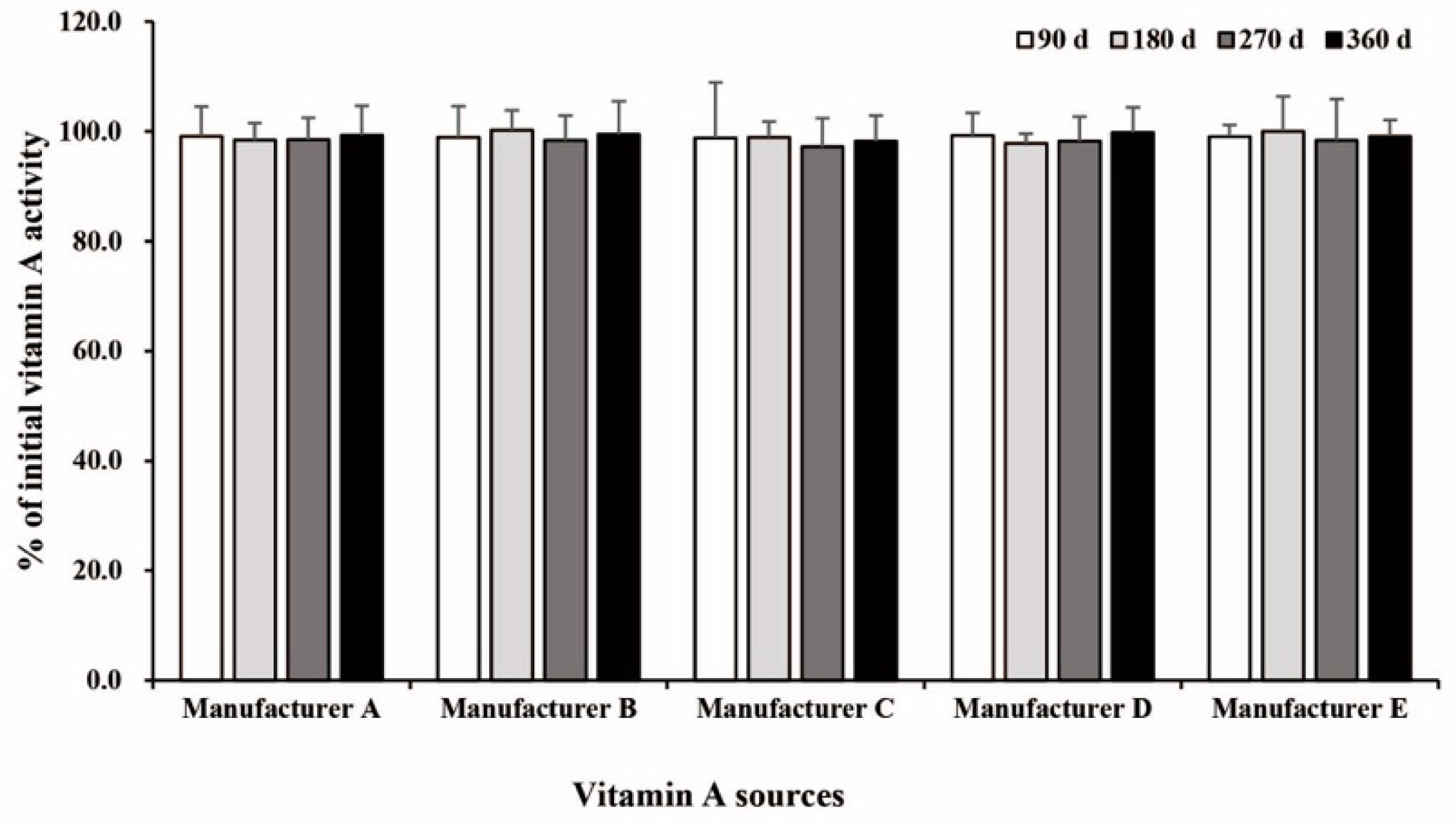
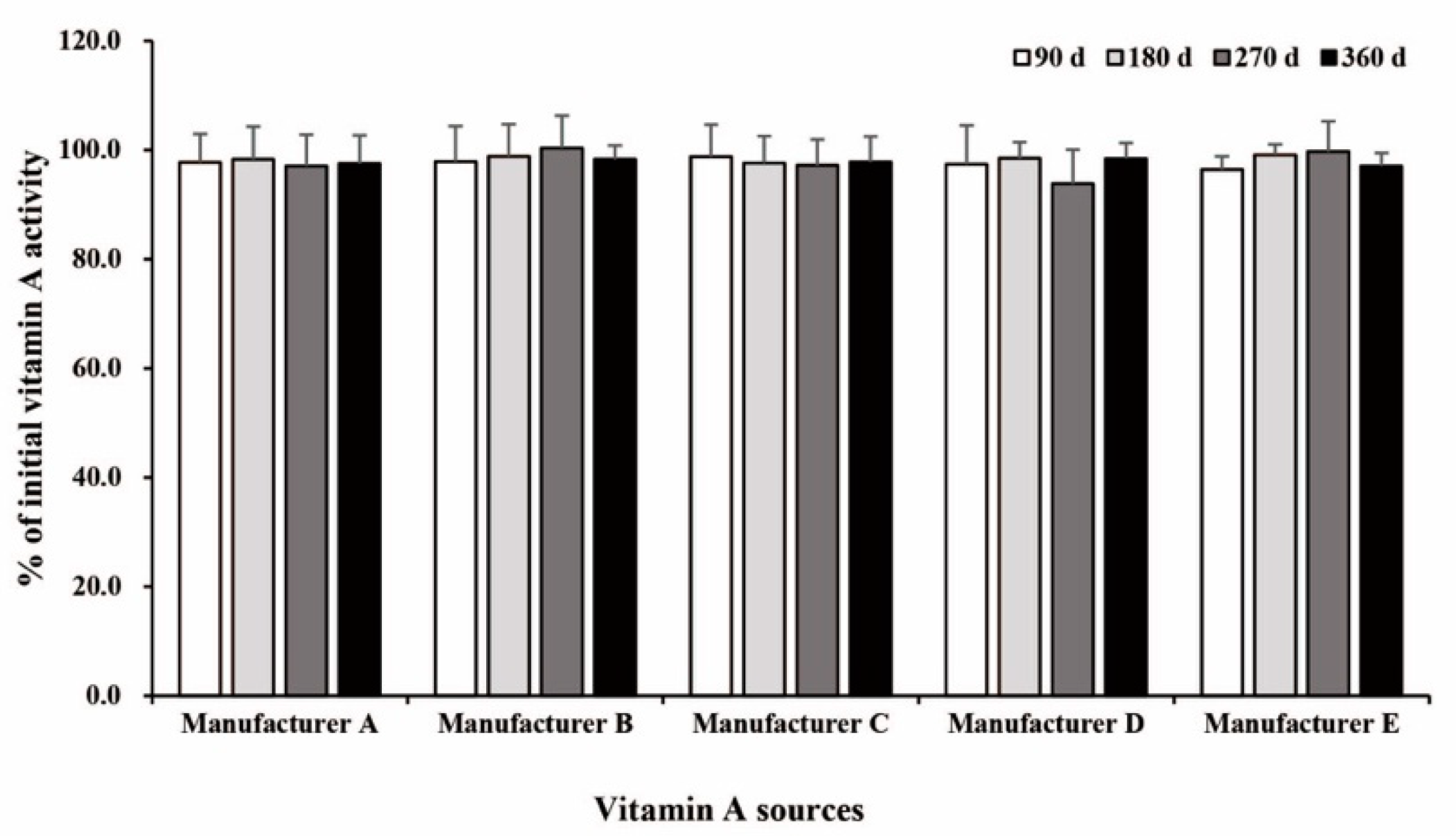
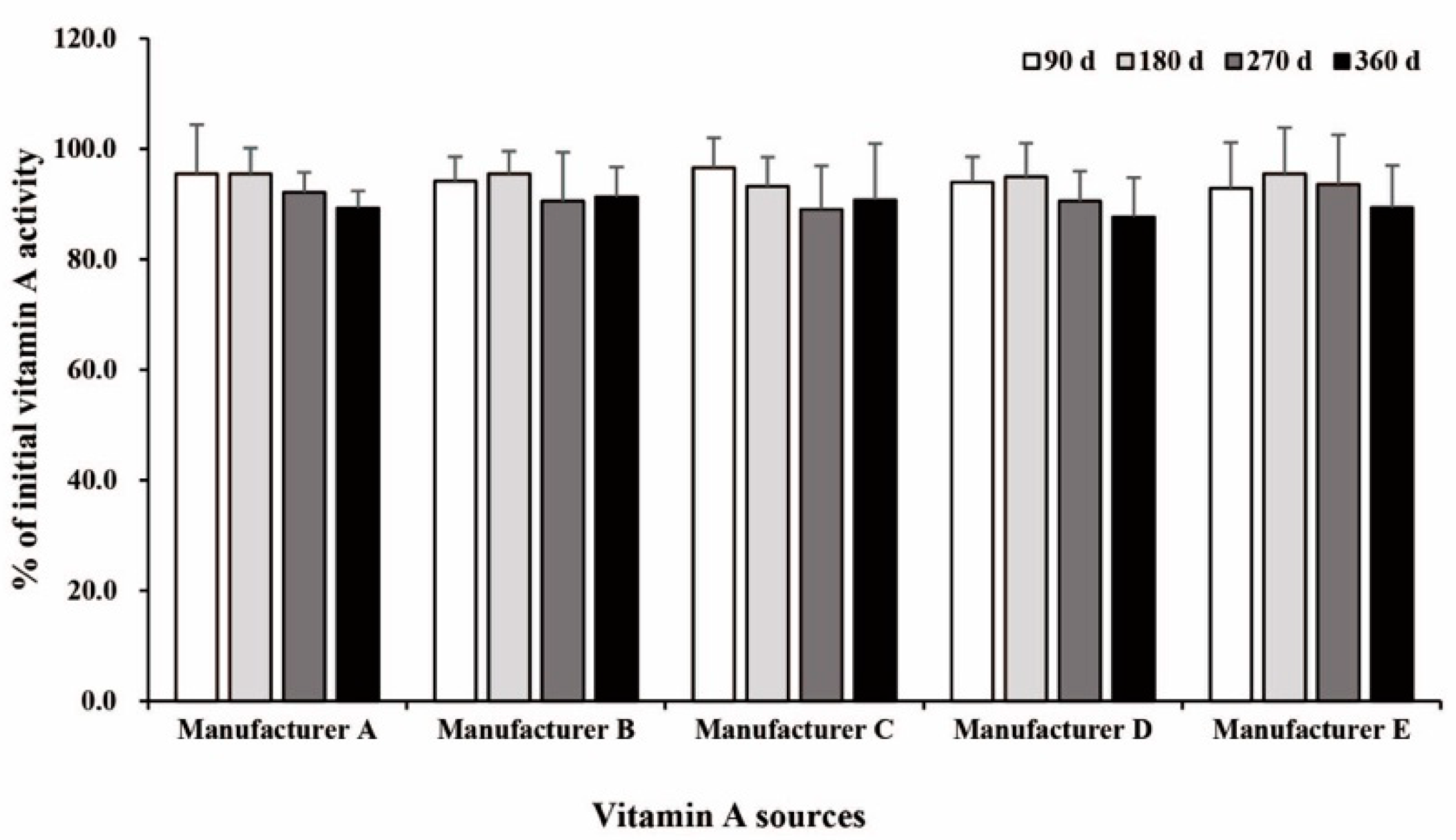
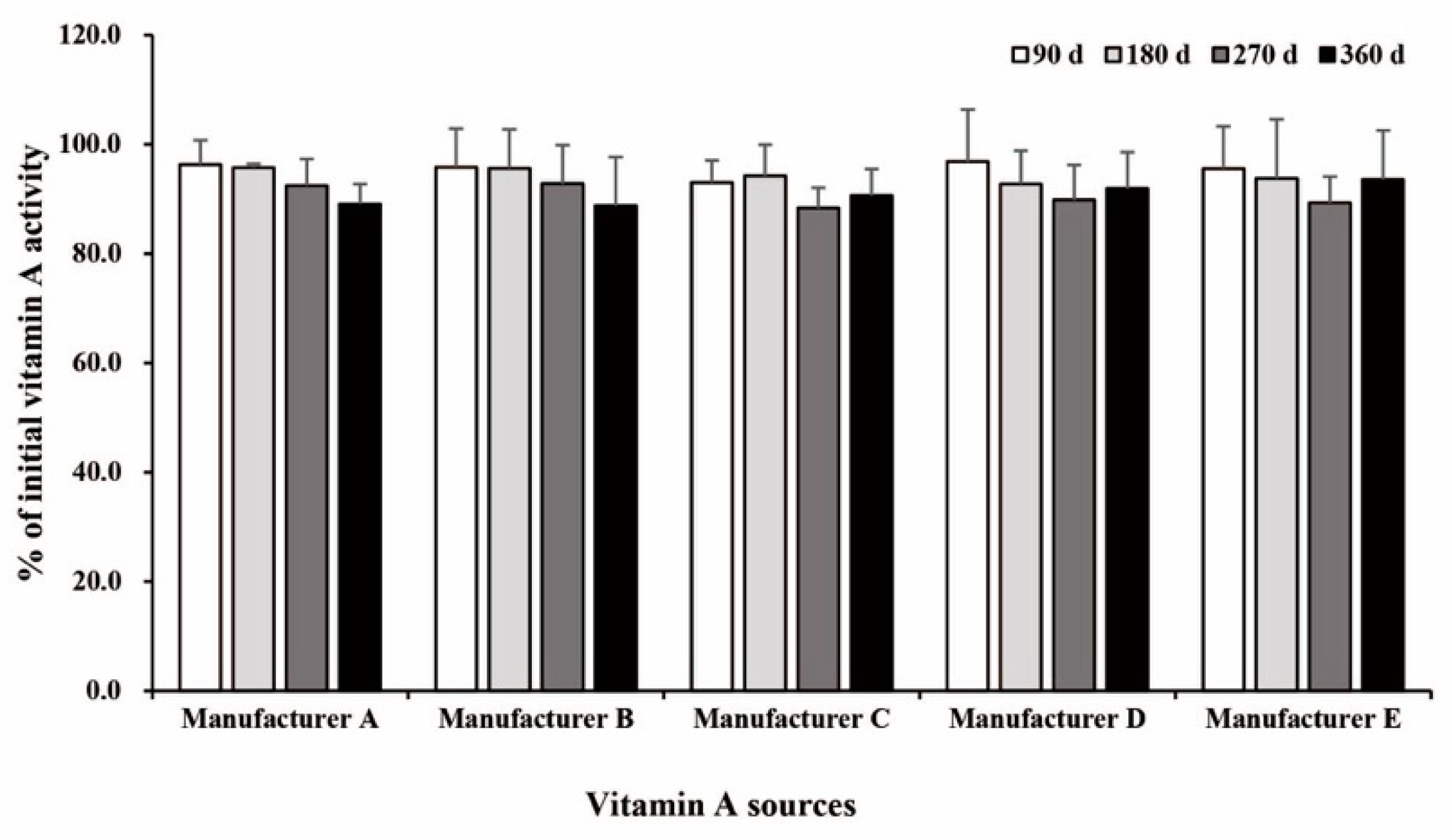
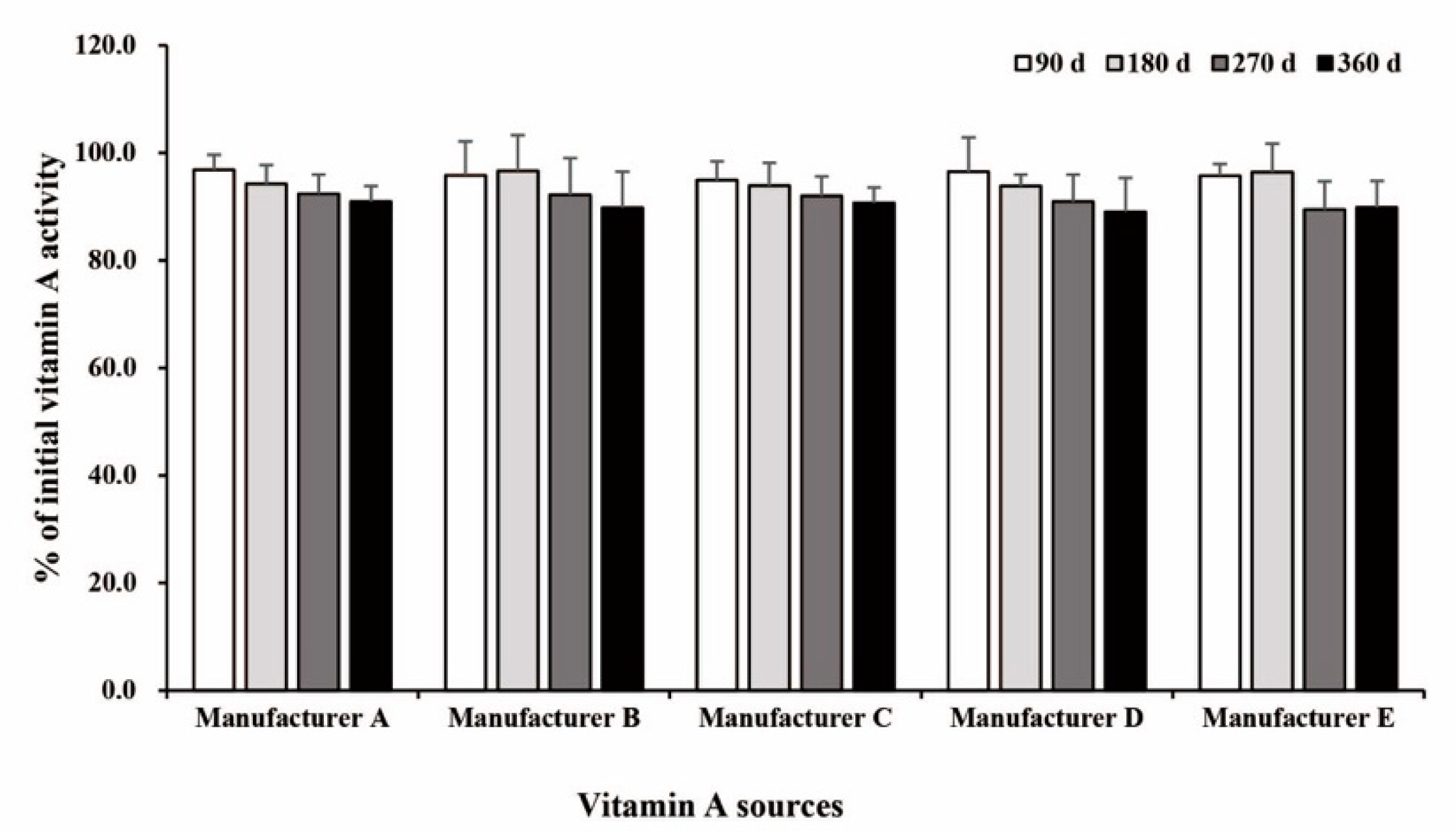
| Item 1 | Vitamin Premixes | VTM Premixes | ||||
|---|---|---|---|---|---|---|
| Suckling | Weanling | Finishing | Suckling | Weanling | Finishing | |
| Vitamin A, 104 IU/kg | 500 | 400 | 267 | 150 | 120 | 80 |
| Vitamin D3, 104 IU/kg | 67 | 67 | 50 | 20 | 20 | 15 |
| Vitamin E, IU/kg | 50,000 | 33,333 | 25,000 | 10,000 | 3000 | 7000 |
| Vitamin K3, mg/kg | 3333 | 1000 | 1333 | 1000 | 300 | 400 |
| Vitamin B1, mg/kg | 167 | 133 | 67 | 50 | 40 | 20 |
| Vitamin B2, mg/kg | 667 | 333 | 333 | 200 | 100 | 100 |
| Vitamin B3, mg/kg | 23,333 | 15,000 | 10,000 | 7000 | 3000 | 4000 |
| Vitamin B5, mg/kg | 13,333 | 11,667 | 10,000 | 4000 | 2000 | 4500 |
| Vitamin B6, mg/kg | 1667 | 1000 | 667 | 500 | 300 | 200 |
| Folic acid, mg/kg | 5000 | 3333 | 3333 | 1500 | 1000 | 1000 |
| Biotin, mg/kg | 2333 | 2333 | 1000 | 700 | 500 | 300 |
| Vitamin B12, mg/kg | 20 | 13 | 17 | 6 | 4 | 5 |
| Choline, mg/kg | - | - | - | 80,000 | 40,000 | 20,000 |
| Copper, mg/kg | - | - | - | 1500 | 1500 | 500 |
| Iodine, mg/kg | - | - | - | 12,000 | 10,000 | 4000 |
| Iron, mg/kg | - | - | - | 3500 | 3000 | 1500 |
| Manganese, mg/kg | - | - | - | 12,000 | 10,000 | 5000 |
| Selenium, mg/kg | - | - | - | 100 | 100 | 100 |
| Znic, mg/kg | - | - | - | 30 | 30 | 30 |
| Item | Time × Source | Time | Source |
|---|---|---|---|
| Vitamin premix (Suckling) | 0.999 | 0.961 | 0.936 |
| Vitamin premix (Weanling) | 0.999 | 0.844 | 0.972 |
| Vitamin premix (Finishing) | 0.907 | 0.903 | 0.802 |
| VTM premix (Suckling) | 0.988 | 0.010 | 0.969 |
| VTM premix (Weanling) | 0.943 | <0.01 | 0.877 |
| VTM premix (Finishing) | 0.984 | <0.01 | 0.925 |
Publisher’s Note: MDPI stays neutral with regard to jurisdictional claims in published maps and institutional affiliations. |
© 2021 by the authors. Licensee MDPI, Basel, Switzerland. This article is an open access article distributed under the terms and conditions of the Creative Commons Attribution (CC BY) license (https://creativecommons.org/licenses/by/4.0/).
Share and Cite
Yang, P.; Wang, H.; Li, L.; Zhang, N.; Ma, Y. The Stability of Vitamin A from Different Sources in Vitamin Premixes and Vitamin-Trace Mineral Premixes. Appl. Sci. 2021, 11, 3657. https://doi.org/10.3390/app11083657
Yang P, Wang H, Li L, Zhang N, Ma Y. The Stability of Vitamin A from Different Sources in Vitamin Premixes and Vitamin-Trace Mineral Premixes. Applied Sciences. 2021; 11(8):3657. https://doi.org/10.3390/app11083657
Chicago/Turabian StyleYang, Pan, Huakai Wang, Longxian Li, Nan Zhang, and Yongxi Ma. 2021. "The Stability of Vitamin A from Different Sources in Vitamin Premixes and Vitamin-Trace Mineral Premixes" Applied Sciences 11, no. 8: 3657. https://doi.org/10.3390/app11083657
APA StyleYang, P., Wang, H., Li, L., Zhang, N., & Ma, Y. (2021). The Stability of Vitamin A from Different Sources in Vitamin Premixes and Vitamin-Trace Mineral Premixes. Applied Sciences, 11(8), 3657. https://doi.org/10.3390/app11083657






